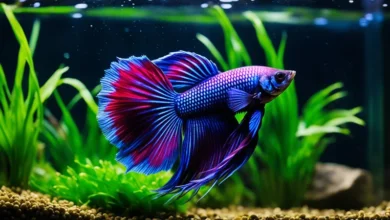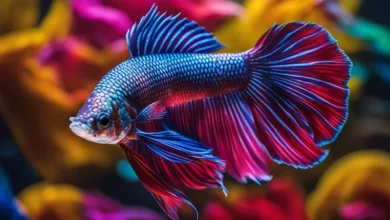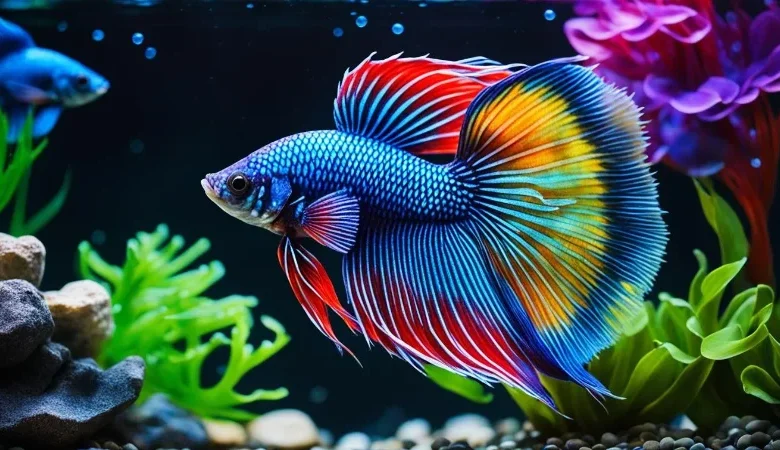
Welcome to the enchanting world of dragon scale betta fish! These mesmerizing aquatic creatures have captured the hearts of fish enthusiasts worldwide with their stunning scales and vibrant colors. But what exactly makes a dragon scale betta fish unique? Are there any remarkable differences between male and female dragon scale bettas? And what about their care requirements?
In this comprehensive article, we will dive deep into the captivating realm of dragon scale betta fish. From understanding their origins and genetics to exploring their defining features and color variations, we will uncover the secrets behind these remarkable creatures. We will also discuss their behavior, habitat needs, dietary preferences, common health issues, and even their vulnerability to a condition known as diamond eye.
So, if you’re ready to embark on an extraordinary journey filled with beauty, fascination, and wonder, join us as we unravel the mysteries of dragon scale betta fish. Let’s begin!
Discovering the Dragon Scale Betta: History and Background
As we dive deeper into the captivating world of dragon scale bettas, it is imperative to understand their rich history and background. These stunning fish have a fascinating lineage that has evolved over time, giving rise to their unique characteristics and allure.
Origins: From Copper PK to Modern Dragon Betta
The origins of the dragon scale betta can be traced back to the copper (PK) betta, known for its metallic scales. Breeders recognized the potential of this trait and sought to enhance it further. Through selective breeding and genetic manipulation, the dragon scale variant was developed, characterized by its thick, iridescent scales reminiscent of a dragon’s armor.
Over time, the dragon scale betta fish has undergone refinement and improvement, resulting in the mesmerizing fish we see today. Through dedicated breeding practices, breeders have fine-tuned these majestic creatures’ coloration, scale patterns, and overall appearance.
Understanding Genetics: The Dragon Scale Mutation
The dragon scale mutation is a result of altered genetic factors that affect the development of the fish’s scales. This mutation causes the scales to be thicker and denser, giving them their distinctive dragon-like appearance. The precise genetic mechanisms behind this mutation are still being investigated, but it is clear that the dragon scale trait is inheritable and can be selectively bred for.
By understanding the genetics behind the dragon scale mutation, breeders can make informed decisions to maintain and enhance this trait in their breeding programs. This knowledge enables them to produce bettas with increasingly vibrant scales and unique variations.
The Significance of Dragon Scale Betta Breeding
Dragon scale betta breeding plays a crucial role in the preservation and development of this alluring fish. It allows for the propagation of desired traits, such as the dragon scale mutation, while ensuring the overall health and well-being of the bettas.
Breeders carefully select and pair bettas with desired traits, considering factors such as color, scale pattern, finnage, and overall health. This meticulous approach helps maintain the high quality and desired attributes of dragon scale bettas while minimizing the potential risks associated with inbreeding.
Through responsible breeding practices, breeders contribute to the ongoing evolution and improvement of the dragon scale betta fish, ensuring its continued existence and delighting enthusiasts with their breathtaking beauty.
Defining Features of Dragon Scale Betta Fish
Dragon scale betta fish are known for their unique and striking physical characteristics that set them apart from other varieties. Let’s explore the defining features that make dragon scale bettas truly captivating.
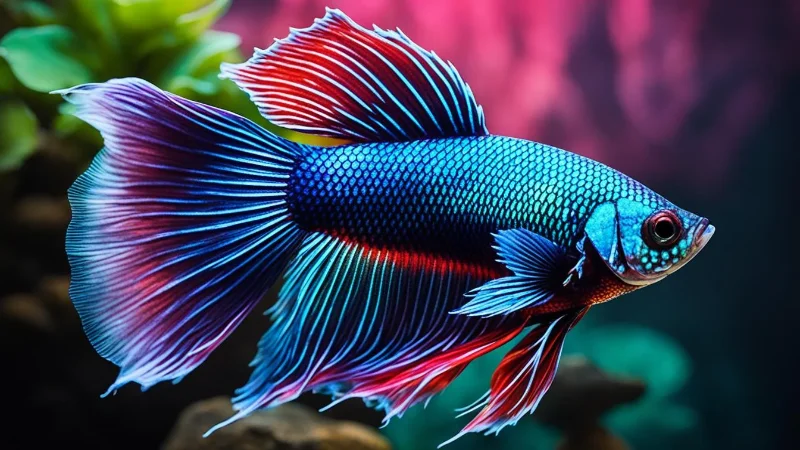
Scales: The most prominent feature of dragon scale bettas is their scales, which have a distinct, iridescent appearance. These scales resemble the mythical dragon’s scales, hence the name. The scales have a thick and raised texture, adding depth and texture to the fish’s overall appearance.
Colors: Dragon scale bettas come in a wide range of vibrant colors, showcasing hues of red, blue, black, white, and everything in between. The combination of the dragon scale texture and these brilliant colors creates a dazzling display that is sure to mesmerize any observer.
Fin Types: Dragon scale bettas can have various fin types, including the popular veil, delta, and crown tail fins. These fins add elegance and grace to their appearance, enhancing their overall beauty.
Overall Appearance: The combination of the unique scales, vibrant colors, and graceful fin types gives dragon scale bettas an enchanting and majestic appearance. Their striking visuals make them a favorite among fish enthusiasts and hobbyists.
By understanding these defining features, it becomes easier to identify and appreciate dragon scale bettas. Their distinctive scales, colors, and fin types truly make them a standout in the world of betta fish.
A Closer Look at Dragon Scale Patterns and Color Variations
Dragon scale betta fish are known for their stunning patterns and vibrant colors. Let’s explore some of the intricate designs and variations that make these fish truly remarkable.
White Scaled Red Dragons and Other Color Combinations
The white-scaled red dragon is one of the most popular color combinations in dragon scale betta fish. These fish showcase a striking contrast between their white scales and fiery red bodies, creating a captivating visual display. Other color combinations include black, blue, and multicolored scales paired with a range of vibrant base colors such as yellow, green, and purple.
The Importance of Metallic Sheen: Identifying True Dragon Scales
When examining dragon scale bettas, one of the key characteristics to look out for is their metallic sheen. True dragon scales have a reflective and iridescent appearance, giving them a distinct shimmer. This metallic sheen adds an extra layer of beauty to their already mesmerizing patterns and colors. So, if you’re trying to identify a true dragon scale betta, pay attention to its metallic sheen.
Uncovering Myths: Blue Dragon Scale Bettas Explained
There is a common myth surrounding blue dragon scale bettas. Contrary to popular belief, blue dragon scales do exist and are not a result of crossbreeding with other betta varieties. These bettas exhibit stunning blue scales with intricate patterns, similar to their counterparts in other color variations. So, if you come across a blue dragon scale betta, know that it is a genuine and enchanting member of this unique breed.
Behavior and Temperament: Understanding Your Dragon Scale Betta
When it comes to understanding your dragon scale betta, it’s important to pay attention to their behavior and temperament. These beautiful and vibrant fish have unique instincts and preferences, which can help you create a suitable environment for them.
Dragon scale bettas, like other betta fish, are known for their territorial nature. They can be quite aggressive and may not tolerate the presence of other fish in their tank. It’s crucial to provide them with an adequate amount of space and plenty of hiding spots to create territories within their habitat.
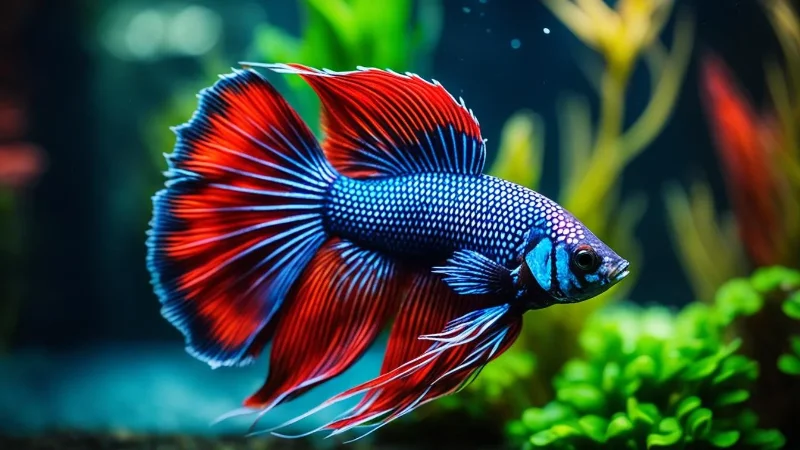
In terms of preferred environments, dragon scale bettas thrive in warm water temperatures ranging from 76 to 82 degrees Fahrenheit (24 to 28 degrees Celsius). They also prefer a slightly acidic to neutral pH level of around 6.5 to 7.5.
To ensure the well-being of your dragon scale betta, it’s essential to provide them with a balanced diet consisting of high-quality betta pellets, supplemented with occasional treats such as bloodworms or brine shrimp. Feed them small portions a few times a day, carefully observing their feeding habits to avoid overfeeding.
Understanding the behavior and temperament of your dragon scale betta fish will help you create an ideal environment and ensure their overall well-being. Observing their instincts and preferences and providing proper care and attention will enable these magnificent fish to thrive in your aquarium.
Dragon Scale Betta Fish Male vs Female: Notable Differences
When it comes to dragon scale betta fish, there are some notable differences between males and females. These differences can be observed in various aspects, including fin types, colors, social dynamics, and care considerations.
Comparing Fins and Colors: Male and Female Attributes
One of the key differences between male and female dragon scale bettas is their fin types. Males typically have longer, more elaborate fins compared to females. Their fins are often vibrant and flowing, enhancing their display and making them a popular choice among betta enthusiasts.
Females, on the other hand, have shorter and more practical fins. While their fins may not be as showy as those of males, they are still beautiful in their own right. Female bettas often have sleeker and more streamlined bodies, allowing them to move swiftly in the water.
When it comes to colors, both male and female dragon scale betta fish can have a wide range of hues. However, males tend to exhibit more intense and vibrant colors. They can showcase bold and striking combinations, making them visually stunning. Female dragon scale bettas, on the other hand, may have more subtle color patterns, but they are equally captivating in their unique way.
Social Dynamics in Dragon Scale Bettas
Understanding the social dynamics of dragon scale bettas is important when keeping them in a community tank. Male dragon scale bettas are known for their territorial behavior. They can be aggressive towards other males, especially when it comes to defending their territory or competing for mates.
Female dragon scale betta fish, on the other hand, are generally less aggressive. They can live harmoniously with other female bettas and even some non-aggressive species. However, it is essential to monitor their interactions and provide ample space and hiding spots to help reduce any potential conflicts.
Care Considerations for Female Dragon Scale Bettas
While both male and female dragon scale bettas require proper care, there are some specific considerations for female bettas. Female bettas have the potential to become egg-bound, meaning they retain their eggs without being able to release them. This condition can be life-threatening if not addressed promptly.
To prevent or treat egg-binding, it is important to provide female bettas with extra care and monitoring. Ensuring their tank has appropriate water conditions, including temperature and water quality, and offering a varied and nutritious diet can help maintain their overall health and well-being.
Setting Up the Perfect Habitat for Dragon Scale Bettas
Creating the ideal habitat for your dragon scale bettas is crucial to their well-being and overall health. By providing the right tank size, water parameters, temperature, filtration, and enrichment, you can ensure a comfortable environment for your beloved fish.

Tank Size: Dragon scale bettas require a tank that is at least 5 gallons in size. This allows them ample space to swim and explore, promoting their physical and mental well-being.
Water Parameters: Maintain a clean and stable environment for your dragon scale bettas by keeping the water pH between 6.5 and 7.5, the temperature between 76°F and 82°F, and the water hardness around 5 to 20 dGH (degress General Hardness).
Filtration: Installing a reliable and adjustable filter in your betta tank is essential for maintaining water quality. It helps remove debris and toxins, keeping the environment clean and safe for your fish.
Hiding Spots and Enrichment: Creating hiding spots in the form of plants, caves, or ornaments is crucial for your dragon scale bettas. They appreciate having places to retreat and feel secure. Additionally, adding floating plants and interactive toys can provide mental stimulation and enrich their environment.
By carefully setting up the habitat for your dragon scale betta fish, you are ensuring their comfort and promoting a healthy and happy life for these stunning fish.
Nutrition and Diet: Feeding Your Dragon Scale Betta for Optimal Health
Proper nutrition is essential for maintaining the health and vitality of your dragon scale betta fish. As carnivorous creatures, bettas have specific dietary requirements that need to be met to ensure their well-being.
The Carnivorous Nature of Bettas
Dragon scale bettas are naturally carnivorous and thrive on a diet rich in protein. Their diet should primarily consist of meaty foods to provide the necessary nutrients for growth and overall health. Feeding them a balanced diet is crucial for promoting their vibrant colors and enhancing their immune system.
Live, Frozen, and Dry: A Balanced Diet Approach
When it comes to feeding your dragon scale betta, a balanced diet is key. You can provide a variety of food options to cater to their natural feeding habits. Consider incorporating the following types of food into their diet:
- Live Food: Live food such as brine shrimp, daphnia, and bloodworms are excellent sources of protein and stimulate the betta’s hunting instinct. You can find live food options in most pet stores, or you can even culture your own.
- Frozen Food: Frozen food, such as frozen brine shrimp or bloodworms, is a convenient and nutritious option for bettas. These foods retain essential nutrients and are readily available in most pet stores.
- Dry Food: High-quality dry food pellets specifically formulated for bettas can be a staple in their diet. Look for pellets that list protein as the main ingredient and avoid those with excessive fillers or grains.
Portion Control and Feeding Schedules
Portion control is crucial to avoid overfeeding your dragon scale betta. Overfeeding can lead to various health issues, including obesity and digestive problems. A good rule of thumb is to feed your betta an amount they can consume within a few minutes, two to three times a day.
Establishing a regular feeding schedule is also essential for betta fish. Consistency in feeding times can help them develop a routine and ensure they receive the necessary nutrients on a regular basis. Try to feed your dragon scale betta at the same times each day to promote their overall well-being.
Common Health Issues and Prevention for Dragon Scale Bettas
Ensuring the health and well-being of your dragon scale betta fish should be a top priority. Like any living creature, bettas are susceptible to various health issues that can impact their overall vitality. This section will explore some common betta diseases and provide valuable tips for prevention, promoting betta health.
1. Swim Bladder Disorder: This condition affects the fish’s ability to maintain buoyancy, resulting in difficulties swimming or floating strangely. To prevent this, avoid overfeeding your betta and provide a balanced diet with suitable portions.
2. Fin Rot: Fin rot is a bacterial infection that causes deterioration and rotting of the betta’s fins. Maintain optimal water conditions by regularly cleaning the tank and treating the water with a suitable conditioner.
3. Ich: Ich, also known as white spot disease, is a parasitic infection characterized by the presence of white spots on the fish’s body. Keep the tank water clean and monitor the temperature to prevent ich outbreaks.
4. Velvet Disease: Velvet disease is caused by parasitic protozoa that give the betta’s skin a velvet-like appearance. Maintain good water quality, maintain optimal temperature, and quarantine new fish to prevent the spread of velvet disease.
5. Dropsy: Dropsy is a condition characterized by bloating, pinecone-like scales, and swelling. Maintain a clean tank with good filtration, and ensure the water parameters are suitable for bettas to prevent dropsy.
Prevention Tips:
- Regularly clean and maintain the betta’s tank to ensure optimal water conditions.
- Provide a balanced diet appropriate for betta fish, avoiding overfeeding.
- Quarantine new fish before introducing them to the main tank to prevent the spread of diseases.
- Monitor and maintain proper water temperature and quality.
- Observe your betta fish regularly for any signs of illness or abnormal behavior.
By following these prevention tips and being proactive in monitoring your dragon scale betta fish health, you can help create a supportive environment for their well-being and minimize the risk of common betta diseases.
The Dragon Scale Betta’s Unique Vulnerability: Diamond Eye
Recognizing the Signs of Blindness in Bettas
Betta fish, including the mesmerizing dragon scale bettas, can sometimes experience a condition known as diamond eye. Diamond eye is a vision impairment that can affect the overall well-being of these beautiful fish. It is crucial for betta owners to be able to recognize the signs of blindness in their fish.
Managing Dragon Scale Bettas with Vision Impairment
When a dragon scale betta develops diamond eye, it is important to provide them with the necessary care and support to manage their vision impairment. Creating a safe and comfortable environment within their tank helps minimize stress and allows them to navigate their surroundings more easily. Adding easily identifiable landmarks, such as plants or decorative elements, helps them orient themselves.
- Keep the tank clean and free from sharp objects that could potentially harm the fish.
- Avoid rearranging the tank decor frequently to help the fish establish familiar territories.
- Ensure that the water quality is optimal, as poor water conditions can exacerbate vision problems.
- Monitor the betta fish closely for any signs of distress or worsening vision impairment.
Ethical Breeding Practices and Diamond Eye Prevention
Preventing diamond eye in dragon scale bettas begins with ethical breeding practices. Responsible breeders prioritize the health and well-being of the fish, taking precautions to minimize the risk of genetic conditions such as diamond eye. By selecting breeding pairs carefully and avoiding the breeding of fish with known visual impairments, breeders can significantly reduce the occurrence of this condition in future generations of dragon scale betta fish.
By recognizing the signs of blindness, managing vision impairment, and promoting ethical breeding practices, betta owners and breeders can contribute to the overall well-being and quality of life for dragon scale betta fish.
Conclusion
In conclusion, understanding the unique traits and requirements of dragon scale betta fish is crucial for their well-being and happiness in captivity. Throughout this article, we have explored the history and background of dragon scale bettas, their defining features, color variations, behavior and temperament, and their specific care needs. It is clear that these mesmerizing fish require special attention and care to thrive.
By delving into the genetics and breeding practices behind the dragon scale mutation, we gain a deeper appreciation for the beauty and rarity of these fish. Their unique scales and vibrant colors make them a standout choice for any aquarist looking to add a touch of elegance to their tank.
Providing a suitable habitat, proper nutrition, and monitoring for common health issues are all essential aspects of responsible dragon scale betta fish care. It is important to create an environment that mimics their natural habitat, while also ensuring they receive a varied and nutritious diet to support their well-being. Regular observation and preventive measures can help maintain their health and detect any possible issues early on.
As you embark on your journey as a dragon scale betta fish owner, remember to educate yourself about their unique vulnerability to the diamond eye condition. Ethical breeding practices play a significant role in preventing this condition and safeguarding the long-term health of these remarkable fish.
FAQ
What is a dragon scale betta fish?
A dragon scale betta fish is a type of betta fish that possesses a unique genetic mutation that causes its scales to have a dragon-like appearance. The scales have a thickened and raised texture, giving them a distinctive dragon scale pattern.
How do I identify a dragon scale betta?
To identify a dragon scale betta, look for the characteristic pattern of raised and thickened scales that resemble the scales of a dragon. These scales give the fish a rough and textured appearance. Dragon scale betta fish also come in various colors and fin types.
What are the distinguishing features of dragon scale betta fish?
Dragon scale betta fish are known for their textured and raised scales, which give them a unique dragon-like appearance. They often have vibrant colors, such as red, blue, or black, and may have different types of fins, like crowntail or halfmoon.
Are dragon scale bettas more prone to certain health issues?
Yes, dragon scale bettas have a unique vulnerability to a condition known as diamond eye. This condition can cause blindness in the betta fish due to the scales affecting their vision. It is important to be aware of this potential health issue and provide appropriate care.
How should I care for a dragon scale betta fish?
Proper care for a dragon scale betta fish includes providing a suitable habitat with appropriate water parameters, temperature, filtration, and hiding spots. They require a balanced diet consisting of live, frozen, or dry food, and regular monitoring of their health to address any issues promptly.
What are the differences between male and female dragon scale betta fish?
Male and female dragon scale bettas may differ in fin types and colors. Males typically have larger and more elaborate fins, while females have smaller and less elaborate fins. There may also be differences in their social dynamics within a community of dragon scale betta fish.
How can I set up the perfect habitat for my dragon scale betta?
To set up an optimal habitat for your dragon scale betta, provide a spacious tank with appropriate water parameters, temperature, and filtration. It is also essential to offer hiding spots, plants, and enrichment items to create a comfortable and stimulating environment for your fish.
What should I feed my dragon scale betta fish?
Dragon scale betta fish are carnivorous and require a balanced diet. You can feed them a combination of live, frozen, and dry foods. Suitable options include brine shrimp, bloodworms, daphnia, and betta-specific pellets or flakes. Remember to feed them in controlled portions and establish a consistent feeding schedule.
What are some common health issues that affect dragon scale betta fish?
Dragon scale betta fish can be prone to common betta diseases such as fin rot, ich, and swim bladder issues. It is crucial to regularly monitor their health, maintain optimal water conditions, and promptly address any signs of illness through appropriate treatment and preventive measures.
How can I prevent and manage the diamond eye condition in my dragon scale betta?
To prevent the diamond eye condition in your dragon scale betta, it is important to practice ethical breeding and avoid breeding bettas with severe scaling issues. If your betta does develop diamond eye and experiences vision impairment, minimize stress, maintain a stable environment, and provide proper support and care to promote their well-being.

